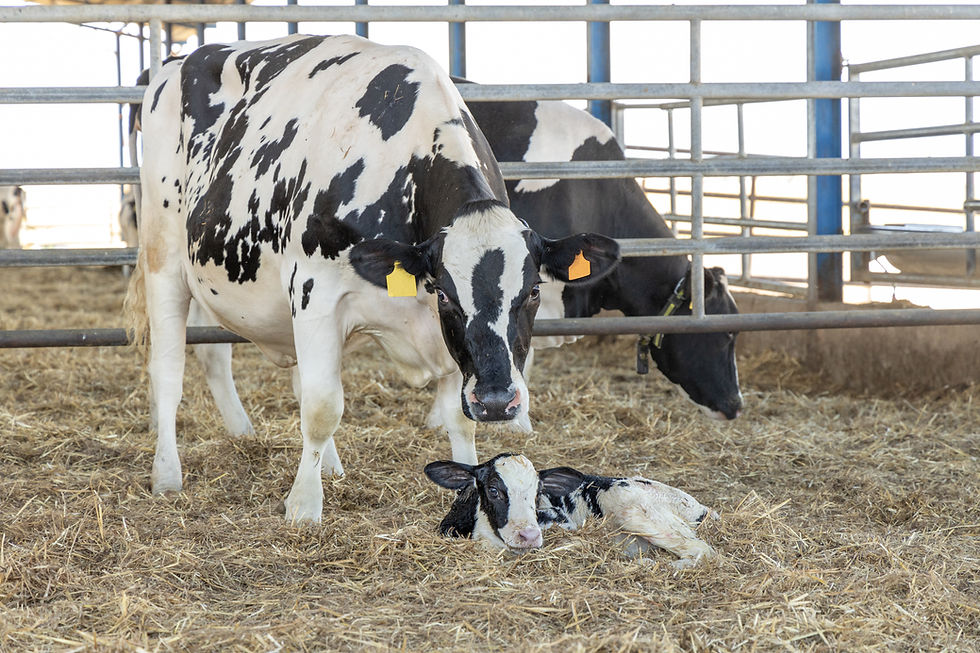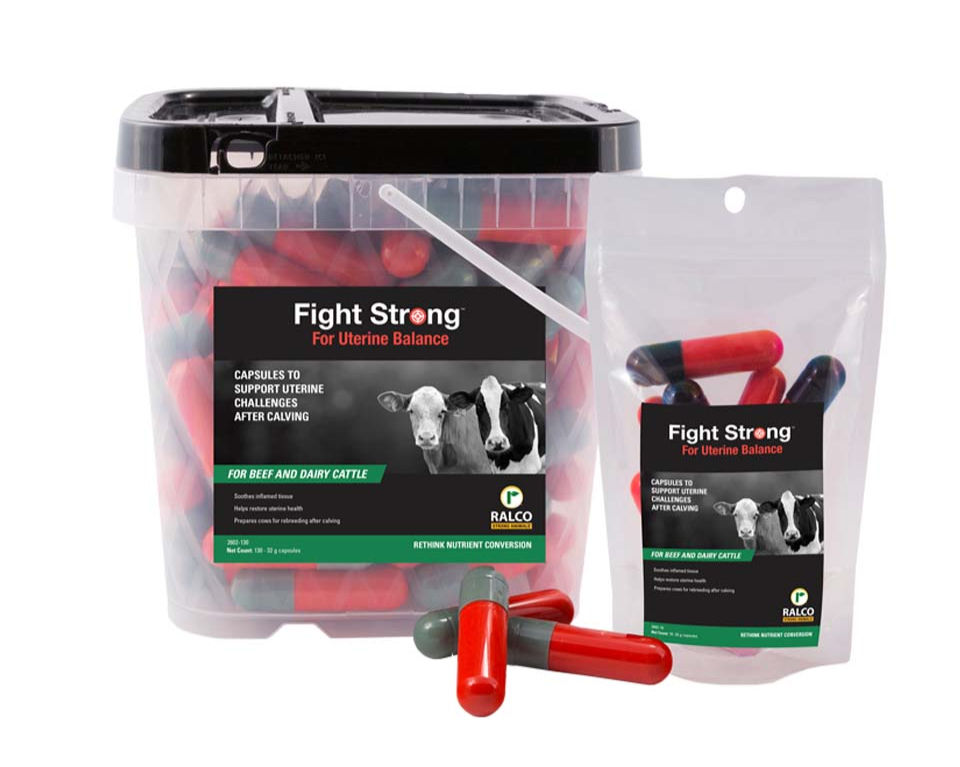How to Reduce the Effects of Uterine Infections in Dairy Cows Naturally
- Ralco Agriculture
- Aug 1, 2025
- 6 min read

Uterine infections are one of the most economically damaging postpartum disorders in dairy cows. A single case of metritis, a serious uterine infection, can cost producers between $329 and $386, and the cumulative toll of decreased fertility, milk loss and treatment costs adds up fast. (1) In fact, the total cost of metritis to the U.S. dairy industry is estimated at $665 million annually. (2)
Most cows experience some level of bacterial contamination in the uterus after calving, and around 18% to 33% go on to develop clinical metritis or endometritis. (3) These infections compromise immune function, delay uterine involution (return to it’s previous size after calving) and lead to longer days open and higher culling rates, making prevention and early support critical to maintaining reproductive performance and profitability.
Why Do Uterine Infections Occur After Calving
During pregnancy, the uterus is sterile and protected by a tightly sealed cervix. But at calving, the cervix dilates and the uterus is exposed to a range of pathogens from the environment. Cows also experience suppressed immune function during this time, making them more vulnerable to infection.
Contaminated maternity pens, poor hygiene, dystocia, retained placenta and metabolic disorders all increase the risk of postpartum uterine disease.
Common bacteria isolated from infected uteri include Escherichia coli, Trueperella pyogenes, Fusobacterium necrophorum, and Prevotella spp., all of which contribute to inflammation and slow the uterus’s return to a healthy state.
The True Cost of Uterine Infections
The impact of uterine infections goes well beyond the uterus. Metritis has been associated with an average delay of seven additional days to first service and a 20% lower conception rate on first service, ultimately extending days open by 19 days. (4) These reproductive setbacks reduce the likelihood of cows remaining in the herd long term.
In addition to fertility losses, cows with uterine infections often experience a measurable drop in milk production that can last for up to 100 days postpartum, particularly when infections are paired with ovarian inactivity. (5) Infected cows may also show reduced appetite and lower dry matter intake, compromising energy balance and suppressing immune function at a time when the cow is already vulnerable.
While antibiotics can be effective in treating metritis, their use is limited by regulatory constraints and milk withdrawal times. Preventing infections through better management and early, biologically based interventions remains one of the most effective ways to protect herd productivity and profitability.
4 Key Ways to Reduce Uterine Infections in Dairy Cows
1. Provide a Clean, Dry Environment for Calving Bacterial exposure is one of the biggest contributors to uterine infections, and it often starts right at calving. When cows give birth in dirty or wet conditions, harmful pathogens like E. coli can easily enter the uterus through the open cervix. Providing a clean, dry and well-bedded space helps reduce that exposure and gives cows a healthier start to recovery.
Use dry straw or sand bedding, disinfect pens between calvings and minimize overcrowding to keep the environment as low-risk as possible.
2. Manage Body Condition to Avoid Calving Complications Over-conditioned dairy cows, those with a body condition score of 3.75 or higher, are more likely to experience difficult calvings, retained placentas and metabolic disorders, all of which increase the risk of infection. (6) Managing body condition through late lactation and the dry period is one of the best ways producers can ensure cows calve smoothly and recover faster. A target BCS of 3.0 to 3.5 is ideal for minimizing complications and supporting a stronger immune response post-calving.
3. Support Immune Function with a Strong Transition Diet Cows naturally experience some immune suppression around calving, so nutrition plays a critical role in whether they bounce back or break down. Balanced transition diets that start three weeks before calving and continue post-fresh should include quality forages, controlled energy levels and key micronutrients like zinc, selenium and vitamin E.
But even the best ration won’t help if a cow goes off feed. Stress, calving trauma or early illness can suppress appetite and energy intake, setting the stage for delayed recovery and increased infection risk.
In these cases, Start Strong for Fresh Cows can help bridge the gap. This performance pack supports appetite and delivers fast-absorbing nutrients during the critical hours after calving. It’s designed to help fresh cows recover quickly and stay on feed by combining technologies and essential nutrients:
Microbial Catalyst Technology – Enhances microbial activity and nutrient digestion in the rumen
Actifibe Prebiotic Technology – Supports beneficial microbes and immune modulation
3-Source Calcium Blend – Supports metabolic recovery and early milk production
Dextrose and Electrolyte Blend – Helps restore hydration and energy balance
Bypass Mineral Blend – Provides highly available trace minerals for immune and metabolic support
Probiotics and Vitamins A, B, C, D, E, K, and Niacin – Replenish essential nutrients for recovery and performance
Start Strong helps fresh cows regain strength, stay on feed and start the next lactation on solid ground.
4. Detect Problems Early and Intervene Promptly Metritis and endometritis don’t always present obvious symptoms right away. That’s why consistent monitoring in the first 10 days postpartum is essential. Keep an eye out for fever, foul-smelling discharge, low appetite or sluggish behavior.
Early intervention improves outcomes and may reduce the need for antibiotics or intensive treatment. Whether it’s supportive care, natural solutions that promote microbial balance or veterinary help, catching infections early protects performance and future fertility.
A Natural Approach to Dairy Cow Uterine Health
An emerging area of focus in dairy cow health is supporting the natural microbial environment of the uterus. Much like the gut, the reproductive tract has its own microbial ecosystem.
When beneficial bacteria like Lactobacillus are present in the uterus after calving, they create an environment that’s less favorable for pathogens. They do this by lowering the pH, crowding out harmful microbes and producing substances that interfere with pathogen growth and attachment. This early microbial balance helps the uterus recover more quickly and reduces the risk of infection taking hold.
Fight Strong for Uterine Balance works with the cow’s biology by providing localized, non-disruptive support when cows are most vulnerable. This post-calving capsule is designed to promote microbial stability and support tissue recovery in the reproductive tract. It contains key technologies that work together to help cows recover efficiently:
Microfused Essential Oils Technology – Helps manage harmful bacteria while preserving beneficial flora
Actifibe Prebiotic Technology – Feeds beneficial microbes and supports microbial balance
Yucca schidigera – Helps manage inflammation and support uterine tissue integrity
Recommended use:
Administer 2 capsules 12–24 hours after calving
Repeat with 2 more capsules 12–24 hours later if needed
By supporting the uterine environment without disrupting healthy microbial communities, Fight Strong helps cows recover more quickly and return to full reproductive performance.
Uterine infections may be common, but they don’t have to compromise your herd’s performance. Good management, proper nutrition and natural tools like Fight Strong for Uterine Balance and Start Strong for Fresh Cows can help your herd recover quickly and return to production faster.
Questions about uterine infections? Give our dairy specialists a call at 507-337-6916 or email RuminantHelp@RalcoAgriculture.com

Start Strong for Fresh Cows - Starter Pack for Fresh Cows
Start Strong for Fresh Cows is a natural performance pack for fresh cows that supports appetite and helps restore vital nutrients immediately after calving.

Fight Strong for Uterine Balance - Helps in Times of Uterine Challenges
Fight Strong for Uterine Balance are natural capsules that soothe inflamed tissue, help restore uterine health and prepare cows for rebreeding.
References:
Bovine Veterinarian. (2020). Managing The Costs Of Metritis With Early Detection And Treatment. Retrieved from https://www.bovinevetonline.com/news/new-products/managing-costs-metritis-early-detection-and-treatment
National Institutes of Health (NIH). Preventing postpartum uterine disease in dairy cattle depends on avoiding, tolerating and resisting pathogenic bacteria. Retrieved from https://pmc.ncbi.nlm.nih.gov/articles/PMC7234917/#:~:text=Furthermore%2C%20the%20use%20of%20antimicrobials,resisting%20infections%20with%20pathogenic%20bacteria.
P.J. Gorden, J.A. Ydstie, M.D. Kleinhenz, L.W. Wulf, R. Gehring, C.J. Lee, C. Wang, J.F. Coetzee, A study to examine the relationship between metritis severity and depletion of oxytetracycline in plasma and milk after intrauterine infusion, Journal of Dairy Science, Volume 99, Issue 10.
Fourichon, Christine & Seegers, Henri & Malher, Xavier. (2000). Effect of disease on reproduction in the dairy cow: A meta-analysis.
Várhidi Z, Csikó G, Bajcsy ÁC, Jurkovich V. Uterine Disease in Dairy Cows: A Comprehensive Review Highlighting New Research Areas. Vet Sci. 2024 Feb 2;11(2):66. doi: 10.3390/vetsci11020066. PMID: 38393084; PMCID: PMC10893454.
Penn State Extension. (2023, January 9). Body Condition in Transition Cows. The Pennsylvania State University. Retrieved from https://extension.psu.edu/body-condition-in-transition-cows


